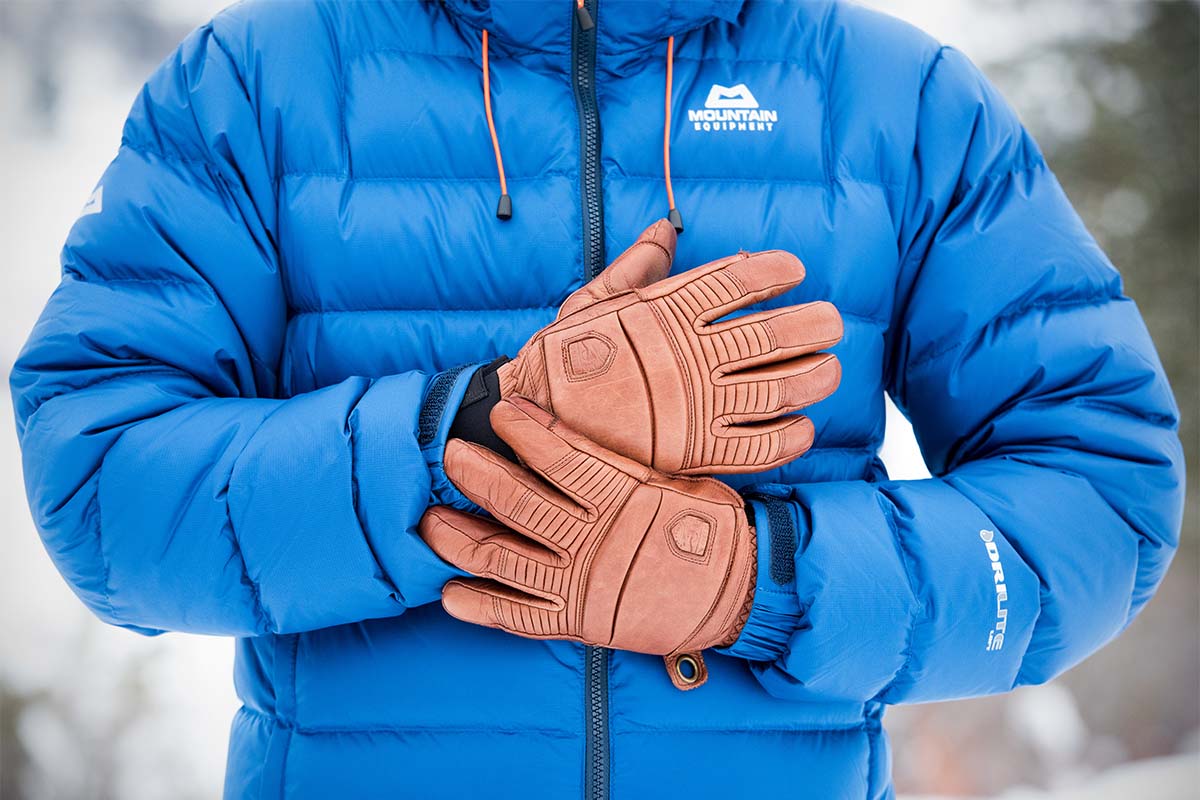
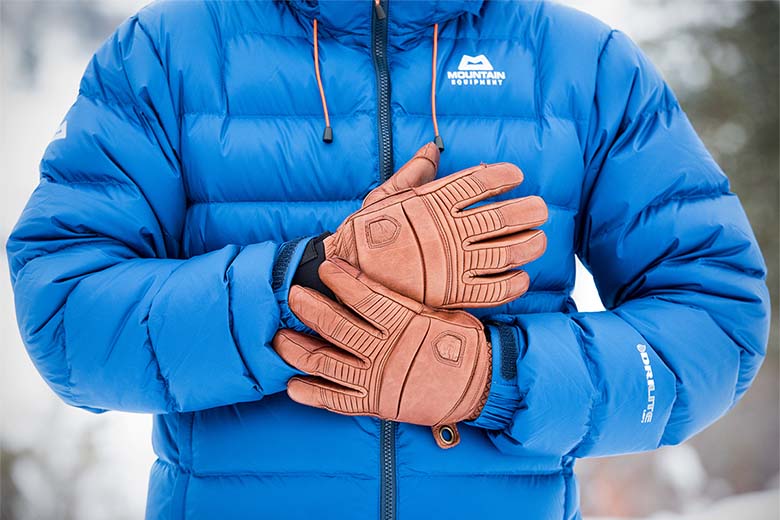
Gloves may not get quite as much attention as your other winter clothing, but they offer invaluable warmth and protection when the temperature drops. Our picks for the best winter gloves of the 2024/25 season span the spectrum from high-performance models for extreme conditions to functional pieces for everyday use and work (many of our favorites blur these category lines). In general, these gloves are unisex and come in a range of sizes, but we've also included a link to the women's-specific version when available. For more background information, see our winter glove comparison table and buying advice below the picks. Finally, if you’re looking for maximum warmth, check out our article on the best winter mittens.
Editor's note: We updated this guide on September 18, 2024, to move Carhartt's W.P. Waterproof Insulated up as our top budget pick. We also included information about our testing practices below the picks and swept the guide to ensure all information was current at the time of publishing.
![]() Category: Performance/casual
Category: Performance/casual
Shell: Nylon/leather
Waterproof: No (water-resistant)
What we like: Ideal warmth and dexterity for most activities; easy on/off via a pull tab and zippered gauntlet.
What we don’t: Not fully waterproof; not as durable as an all-leather design (although still very durable).
Outdoor Research is widely known for their glove collection, so it should come as no surprise to see their name in our top spot. For over four winters, the Stormtracker has been our go-to choice for everything from winter walks and snow shoveling to belay duty, bike commuting, and mild days on the skin track. We’ve simply yet to meet a better all-around glove: It’s the perfect warmth and weight for most activities, easy to get on and off with a zippered gauntlet and large pull tab, incredibly dextrous once broken in (yes, the touchscreen-compatible tips actually work), and relatively weather protective with Gore-Tex Labs' Windstopper fabric. Finally, durability is excellent: We’ve put our pair through the wringer for years and they’re still operating like a well-oiled machine. For $79, that’s a whole lotta value.
The Stormtracker is an excellent part of any glove quiver, and is likely to be the one that gets used the most. That said, you’ll probably get a bit longer lifespan out of a full-leather workhorse like the Kinco or Flylow options below, but at the cost of some dexterity, breathability, and convenience. On the other hand, resort skiers or those frequenting high-mountain environments will want a lot more insulation. Lastly, while Gore’s Windstopper is water-resistant, it’s important to note that the Stormtracker is not fully waterproof. But for a glove that puts it all together for high-output performance use, winter chores, and around-town use, it simply doesn’t get any better.
See the Men's Outdoor Research Stormtracker See the Women's OR Stormtracker
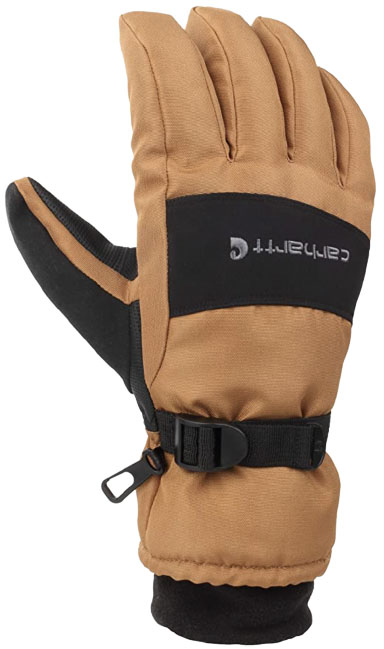 Category: Performance/work
Category: Performance/work
Shell: Polyester
Waterproof: Yes
What we like: Solid performance at a low price.
What we don’t: Bulkier and stiffer than more expensive options.
Carhartt’s large lineup of gloves ranges from thin liners to burly camouflaged hunting models, and their popular W.P. glove lands right in the middle. It’s reasonably soft and moves well enough for casual activities, but with features like a waterproof membrane, nose wipe, and reinforced palm, the W.P. is a serviceable option for outdoor chores and mild days on the slopes. Plus, priced at $30 (and often found on sale for less), the W.P. offers a lot of bang for your buck.
The main pitfall of going with such a budget glove is that in temperatures below freezing, you’ll likely find that the W.P.'s thin layer of cheap synthetic insulation isn’t enough to keep your hands super warm. Furthermore, the Carhartt lacks the versatility and good looks of pricier all-rounders like the OR Stormtracker above, and the polyurethane palm doesn’t move as well as leather. But as a simple and affordable option, the W.P. is one of our favorites. It’s worth noting that Carhartt also makes a W.B. glove (and mitten) for $39, which tacks on leather thumb reinforcements and a hook-and-loop closure on the cuff.
See the Carhartt W.P. Glove
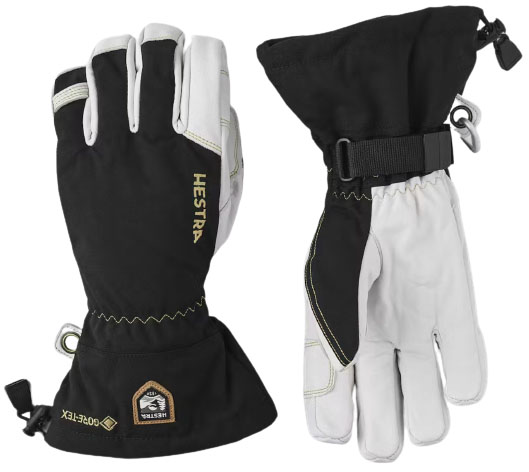 Category: Performance
Category: Performance
Shell: Polyamide/leather
Waterproof: Yes (Gore-Tex)
What we like: A beautifully made glove with premium Gore-Tex membrane.
What we don’t: Expensive; no removable liner.
Whether you’re skiing, snowboarding, or snowshoeing—if you’re spending all day outside in the snow, chances are you’ll want a waterproof and insulated glove. Within this category, the Hestra Army Leather Gore-Tex is a top performer. The Army Leather features a dextrous goat leather palm and polyamide back, along with G-Loft synthetic insulation and a fleece lining. Sandwiched in between is a premium Gore-Tex membrane, which keeps moisture out and is reasonably breathable, too. Originally designed as a ski glove, the Hestra also comes with a full suite of features for a day at the mountain, including wrist leashes and a gauntlet design that secures over your jacket.
We’ve learned to trust Hestra for top-notch build quality, and the Army Leather Gore-Tex delivers in spades. However, it’s far from cheap at $230, and you can find similar waterproof, insulated designs for much less—including the Dakine Titan below. Within this category, it’s also worth thinking about whether or not you want a removable liner glove, which can be conveniently dried or laundered in between days on the slopes (but also adds bulk and detracts from dexterity). In the end, you won’t find a more premium glove for days spent in the snow, which is why we rank the Army Leather Gore-Tex here.
See the Hestra Army Leather Gore-Tex Glove
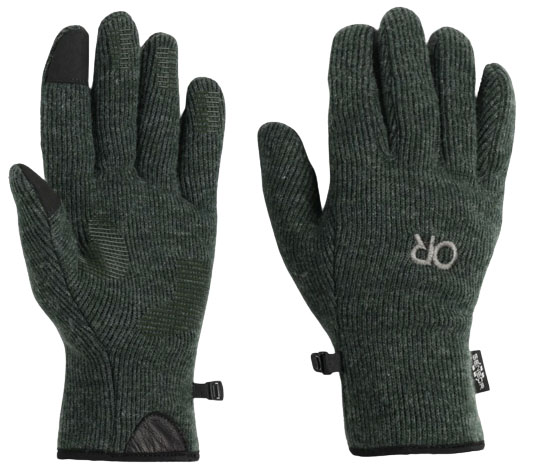 Category: Casual
Category: Casual
Shell: Wool/nylon
Waterproof: No
What we like: Effective touchscreen performance alongside decent warmth.
What we don’t: Not particularly durable and middling wind resistance.
If you live in a wintery climate where gloves are a daily wardrobe staple, a touchscreen-compatible design is invaluable. Whether you’re texting a friend, making a selection at the gas station, or trying to sign your name after a credit card swipe, it’s really nice to be able to do so without exposing your digits to the elements. Among the myriad options, the Outdoor Research Flurry is one of our favorite tools for the job, with reliable and precise touchscreen performance thanks to the synthetic suede patches on both the index finger and thumb. And the rest of the design is equally well-thought-out and executed, including the dextrous wool/nylon shell with soft fleece interior, pull tabs at the wrists, and grippy silicone patches at the palm and fingertips.
A lot of thin gloves feature touchscreen-ready fingertips, but the Flurry offers a step up in warmth from a standard liner without compromising on function. On the other hand, they keep a low enough profile to be worn underneath most waterproof shell gloves—think of them as the midlayer of the glove world. But while we love the OR for casual daily tasks and consider it to be impressively warm compared to most touchscreen-compatible gloves, keep in mind that it’s not a super wind resistant design, and the wool/nylon shell will show wear with use. Finally, the Flurry tends to run a bit large, so you might want to consider sizing down for a close fit and maximum touchscreen performance. For a lighter-weight option from OR, check out their newer Trail Mix Glove ($35).
See the Men's Outdoor Research Flurry See the Women's Outdoor Research Flurry
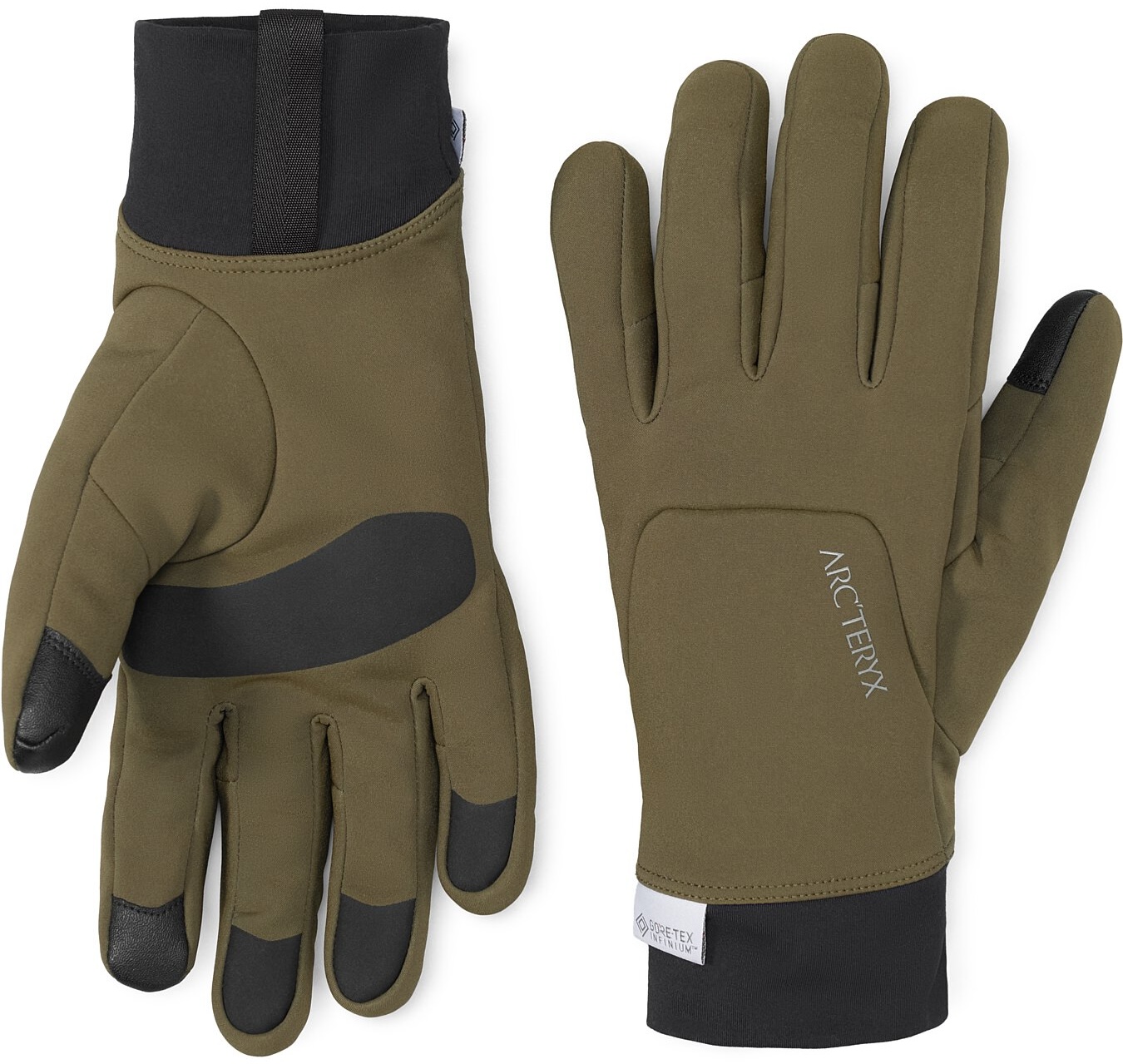 Category: Performance
Category: Performance
Shell: Softshell
Waterproof: No
What we like: A near-ideal mix of warmth, breathability, and windproofing for winter running and cross-country skiing.
What we don’t: Not warm enough for slower-paced activities in cold weather.
If your winter routine involves activities like cross-country skiing or running, you’ll want a glove like the Arc’teryx Venta. The Venta features just enough insulation to cut the chill of a frosty morning (you get a light fleece at the front of the hand and warmer Octa Loft at the back), along with a breathable softshell face that dumps the heat that you’ll inevitably build. And while it’s not quite waterproof, the Gore-Tex Infinium shell is fully windproof and provides a reliable defense against most rain and snow. To top it off, the Venta offers excellent dexterity and grip (great for holding your ski pole or toggling your watch), and the touchscreen patches actually perform as advertised.
We’ve worn a number of different gloves and mittens while winter running and cross-country skiing, and generally have one of two gripes: either our hands get cold, or they get clammy. The Venta gloves are truly the best solution we’ve found for this cold-weather conundrum. But they are a ‘tweener design: We often drop down to a liner glove as temperatures creep toward 40 degrees, and for lower-output activities (even hiking or snowshoeing) in sub-freezing conditions, you’ll certainly want more insulation.
See the Arc'teryx Venta Glove
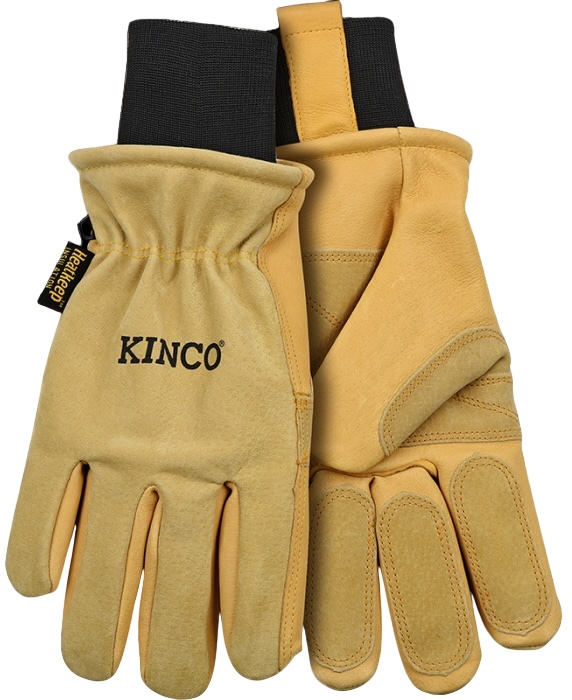 Category: Work
Category: Work
Shell: Leather
Waterproof: No (water-resistant)
What we like: Tough, dexterous, and cheap.
What we don’t: Limited warmth and you’ll have to apply waterproofing wax yourself.
Hard-working hands don’t stop for cold weather, and a solid winter work glove needs to be durable, dexterous, and warm. Glove-specialist Kinco has a full lineup of options for everything from ranching and fishing to construction and equipment operation, and their Heavy-Duty Pigskin Driver (model 901) is one of our favorite designs. This winter work glove features a reinforced pigskin leather shell and a thermal liner for insulation, topped with a high-quality knit wrist to seal heat in. The cherry on top is the price: For just $43 (on Amazon at the time of publishing), you get a workhorse glove that’s waterproof, moves well (once you break it in), and is as tough as the much pricier options on this list.
If you plan to be out a lot in wet conditions, we highly recommend applying a waterproofing wax to the leather and seams to make the gloves fully winter-ready (if you’re lucky, Kinco might include a few Nikwax packages with purchase). And while Kincos are warmer than an unlined work glove, you’ll want to stay fairly active to stave off cold hands, which is not an issue for most people working outside. All in all, thanks to their bargain prices and proven performance, Kinco gloves have reached legendary status in the work world, and they’ve even won over the ski community and lifties in particular.
See the Kinco 901 Heavy-Duty Pigskin Driver
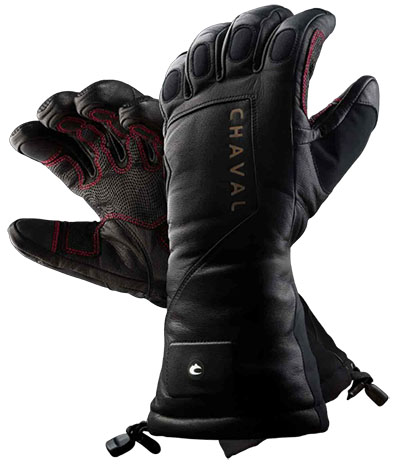 Category: Performance
Category: Performance
Shell: Leather
Waterproof: Yes (Porelle)
What we like: Serious warmth for those who suffer from cold hands; longer-lasting, warmer, and less bulky than competing heated gloves.
What we don’t: Expensive.
If you struggle with persistently cold hands or simply want to maximize warmth, a heated glove can make a world of difference. While household names like Outdoor Research, Black Diamond, and Hestra all have a heated glove in their lineup, far and away the best model we’ve tested is from a little brand called Chaval. Based on an island off the coast of Seattle, Chaval specializes in heated gloves and mittens, and their SuperNova Heated Glove offers a premium feel and performance that you just don’t get from other brands. Chaval’s Alphaheat technology has climate control that responds to the temperature of your hands—no need to toggle it on or off, up or down—works in sub-zero (Fahrenheit) temperatures, and lasts for significantly longer than other brands (4 to 6 hrs compared to the OR Prevail’s 2.5 hrs on high, for example).
The SuperNova Gloves are also easy to recharge: Unlike other brands, they don’t require you to remove any batteries from the cuff—simply disengage the plug inside and insert it into the charger. They also have technology that dries them out as they charge, which is a bonus if you’ve spent the day sweating in your gloves. Finally, we’ve found that Chaval’s offerings are more dexterous than other heated gloves thanks to heating tech that uses a thin polymer film rather than wires. Of course, the biggest impediment of a heated glove is cost, and at $425, the SuperNova is far and away the most expensive design to make our list. But it's hard to put a price on comfort, and these gloves are the real deal when it comes to keeping your hands cozy throughout the day.
See the Chaval SuperNova Heated Glove
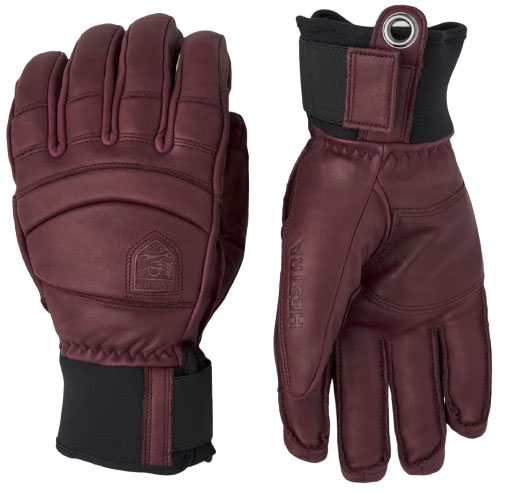 Category: Performance/casual
Category: Performance/casual
Shell: Leather
Waterproof: No (water-resistant)
What we like: Premium build quality and dexterity.
What we don’t: Expensive and not waterproof.
Hestra gloves are kind of like a work of art. The Swedish company has a long track record of craftsmanship, and their Fall Line is a versatile design that’s equal parts ski glove and everyday workhorse. This all-leather glove nails the essentials: It’s comfortable, well built, and tough. What's more, it offers sufficient insulation and cushioning on the back of the hand for most winter sports (it earned a spot in our article on the best ski gloves), but is dexterous enough to use while driving, shoveling, and simply walking around town. And the glove is made to last—our well-worn pair has softened and conformed to our hand, giving it a custom feel that still performs like new (consistent maintenance has helped here).
The biggest downside of the Fall Line is its steep $165 price. You’re paying for quality and the feel is phenomenal, but this is a hearty investment for a glove you won’t wear on the coldest days (if we’re inactive, we’ve found that it’s only warm enough down to about 20°F). Also, the Fall Line is not fully waterproof, although occasionally treating the leather will keep it from soaking up too much moisture. All in all, designs like the Flylow Gear Ridge and Oyuki Sencho below are the better values, but the Hestra’s premium look is something we appreciate each and every time we slip them on.
See the Men's Hestra Fall Line See the Women's Hestra Fall Line
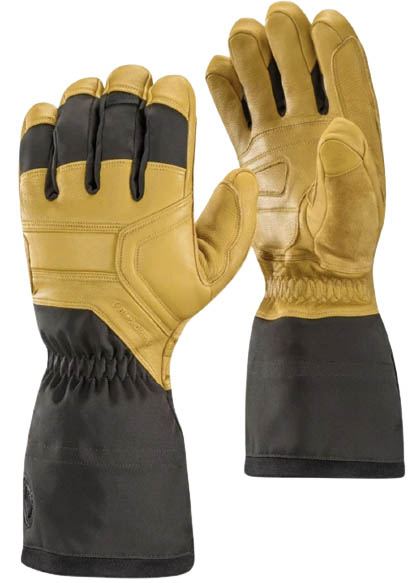 Category: Performance/work
Category: Performance/work
Shell: Leather/nylon
Waterproof: Yes (Gore-Tex)
What we like: A premium glove that’s versatile for both skiing and everyday use.
What we don’t: Takes some time to break in; below-average dexterity.
Black Diamond’s Guide Gloves are legendary among hardcore skiers for their impressive warmth and durability, but their appeal extends far beyond the slopes. This primo winter glove features a completely waterproof design with a proven Gore-Tex insert, removable liner complete with PrimaLoft synthetic and thick boiled wool, and robust nylon shell with leather reinforcements. What’s more, the generous over-the-cuff gauntlet extends well below the wrist, giving you extra coverage and protection whether you’re hitting big lines, putting on tire chains, or building a snowman with the kids.
The downside to all this material is that the Guide Gloves can take some time to break in. Even after a few years of consistent use, our pair still lacks the flexibility that you get right out of the box with a thinner design like the Kinco or Outdoor Research Stormtracker above (the extra knuckle padding doesn’t help). But it’s a compromise many are willing to make for the added warmth, and we love that the Guide pulls it off while still looking great for casual use. All told, if you’re willing to deal with the slight sacrifice in dexterity, the Black Diamond offers a hard-to-beat combination of protection, durability, and versatility.
Read more: Black Diamond Guide Gloves review
See the Black Diamond Guide Gloves
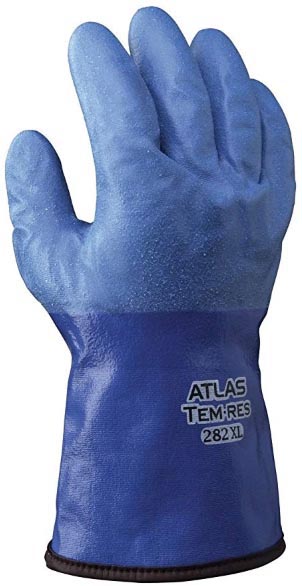 Category: Performance/work
Category: Performance/work
Shell: Polyurethane
Waterproof: Yes
What we like: The glove that does it all for less than $30.
What we don’t: Far from the most fashion-forward glove on our list.
The majority of outdoor enthusiasts have probably never heard of Showa, and their Atlas 282 TemRes glove certainly isn’t filling the racks at your local gear shop. But don’t let appearances deceive you: For years, the Atlas 282 TemRes has been a top choice for everything from ice climbing and backcountry skiing to shoveling the driveway. Combining a polyurethane exterior with a soft, fleecy liner, this glove is—no joke—both waterproof and breathable. And that’s not all: It’s warm, dexterous, and incredibly grippy too.
In many ways, the Atlas 282 TemRes is a miracle of a glove. For less than $30, you get performance on par with models over five times the price. Sure, the TemRes look funny, they’re not as durable as leather, and they don’t have technical features such as cuffs, gauntlet cinches, or carabiner attachment points (check out the 282-02 for more climbing-specific features). But we’re almost certain you won’t be disappointed. And we do recommend going up one size, as they’re known to fit small.
See the Showa Atlas 282 TemRes Glove
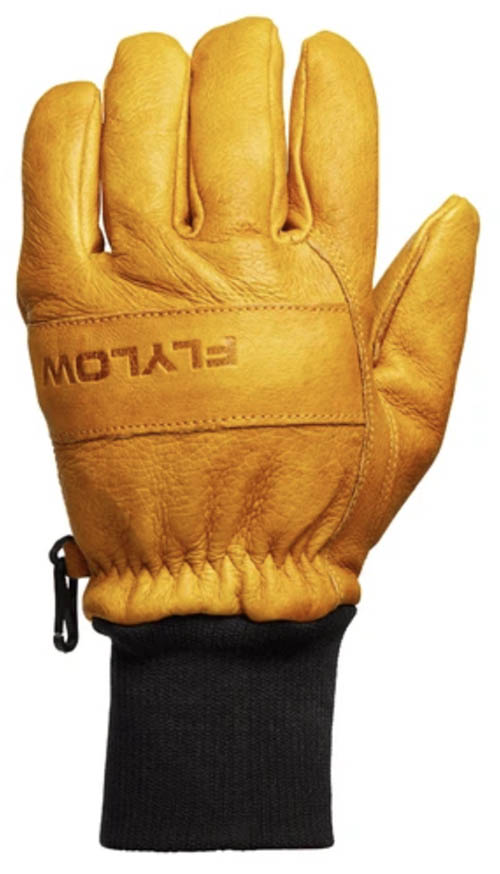 Category: Work/performance
Category: Work/performance
Shell: Leather
Waterproof: No (water-resistant)
What we like: A highly dextrous and comfortable leather glove.
What we don’t: Not as long lasting as the Kincos and almost $20 more.
Flylow’s Ridge glove is a classic. Used (and abused) by lifties and backcountry skiers or stuffed under the seat of a car for emergency use, it has a loyal following that few can match. And for good reason: The combination of pigskin leather, elastic cuff, and soft polyester lining is supple, dextrous, and offers no-nonsense performance. It’s not the warmest leather glove available, but at $55, the Ridge will cost you considerably less than options like Hestra’s Fall Line.
The Flylow Ridge goes head-to-head with the Kinco above: Both are durable leather gloves that can withstand a lot of abuse and just get better with time. The Ridge is a bit quicker to break in but alternately features slightly less insulation and is more likely to pack out over the course of a season. As usual, a final decision will likely come down to your priorities and objectives. If you want an even more budget-friendly option from Flylow, check out their Tough Guy ($50), which is a bit less waterproof with canvas along the back of the hand. On the other hand, the Magarac ($65) tacks on a waterproof membrane for increased wet-weather assurance.
See the Flylow Gear Ridge Glove
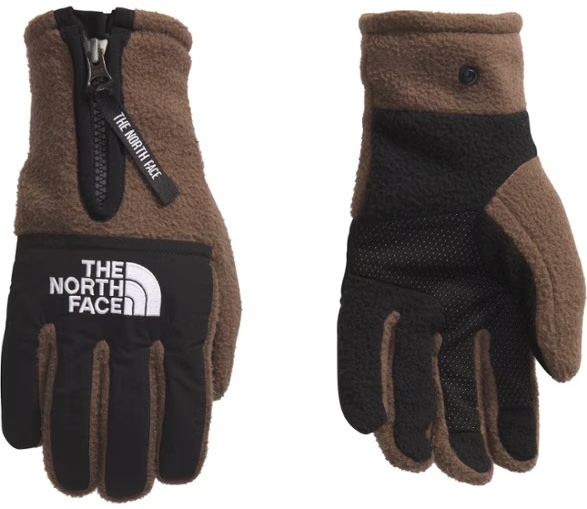 Category: Casual
Category: Casual
Shell: Fleece
Waterproof: No
What we like: A well-appointed fleece glove at a good price.
What we don’t: Too bulky to be a liner glove; fleece isn’t great in wind, rain, or snow.
The Denali Etip is The North Face’s take on a typical fleece glove—cozy, dexterous, and moisture-wicking—but with a few extra features. It includes touchscreen compatibility on the thumb and index finger, a reinforced panel of nylon along the back of the hand for toughness and light weather protection, and a unique zip at the cuff for easy on/off and an extra dose of style. Tack on a comfortable, articulated shape and high-grip palm (great for holding onto trekking poles), and the Denali Etip checks the boxes for a functional, everyday fleece glove that can hold its own on winter trails, too.
Despite its thoughtful feature set, the Denali Etip has limitations. Most importantly, you don’t get the water or wind resistance of a nylon glove like the Outdoor Research Stormtracker above. On the other hand, the bulky fleece isn’t as versatile as thinner designs and doesn’t crossover well for use as a liner. But for what it is—a comfy $50 glove for around town use—the Denali is pretty darn good. It’s also worth checking out The North Face’s popular Etip Recycled Glove ($45), which feature a thinner fleece and can pull double duty as a winter running or liner glove.
See The North Face Denali Etip
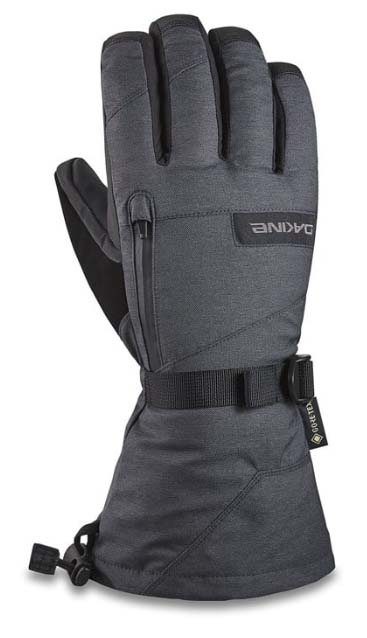 Category: Performance
Category: Performance
Shell: Polyester
Waterproof: Yes (Gore-Tex)
What we like: A ski/snowboarding glove that can pull double duty around town.
What we don’t: Bulky construction impacts dexterity.
Dakine’s Titan has built a solid reputation among skiers and snowboarders alike, but we’ve included it here thanks to its well-rounded nature. With a Gore-Tex insert, the glove provides reliable wet-weather protection, and a grippy palm does well with everything from shoveling the driveway to hauling sleds. Plus, unlike many snowsport-specific gloves, the Titan’s styling translates rather nicely for wearing around town. To top it off, you get removable fleece liners that are touchscreen-friendly and a good weight for wearing on their own while running in the cold.
Where the Titan feels more like a ski glove is the thick insulation and bulk that hurts dexterity. The removable liner plays a role here too, and it can be difficult to do things that require fine motor skills like zipping up jackets or handling car keys. The upside is that you get a lot of warmth at a fair price, and we especially love the zippered pocket (great for stashing a hand warmer) and generous gauntlet for resort skiing.
See the Men's Dakine Titan GTX See the Women's Dakine Sequoia GTX
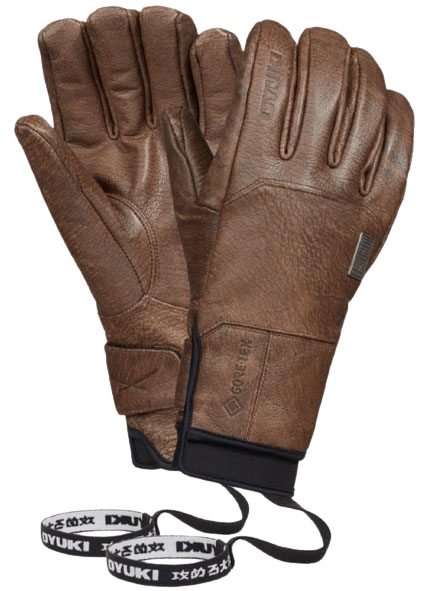 Category: Performance
Category: Performance
Shell: Leather
Waterproof: Yes (Gore-Tex)
What we like: A premium leather glove for less than the Hestra competition.
What we don’t: A bit stiffer than gloves without a waterproof membrane.
With a name that translates to “big snow,” Japan-based Oyuki is a one-stop shop for premium gloves, headwear, and baselayers built for powder-heavy days on the slopes. The Sencho here is a crash course in refinement, with clean styling, top-shelf materials, and an incredible fit and finish. The glove is built with a durable goatskin leather shell and waterproof Gore-Tex membrane, stuffed full of premium 200-gram PrimaLoft Gold insulation (133g PrimaLoft Grip in the palm), and topped off with a soft tricot liner for comfort. Finally, the cuff is a piece of art in and of itself, with a double layer neoprene design that forms a nice seal at your wrist while keeping bulk low.
We’ve worn a pair of Oyuki gloves for the past few seasons of resort skiing, and have been very impressed by their performance. The leather shell softens over time and conforms to the hand, resulting in exceptional comfort and a nice amount of dexterity. It’s true that a non-Gore-Tex design like the Hestra Fall Line above will be even more pliable, but the tradeoff might be worth it for the Oyuki’s full-on waterproofing. And while it's priced a bit lower than the aforementioned Hestra, the Sencho feels just as premium and have the brand-name credentials to back it up. Whether you’re looking for your next ski glove or are in the market for a premium leather workhorse, the Oyuki Sencho is worth a close look.
See the Oyuki Sencho Gore-Tex Glove
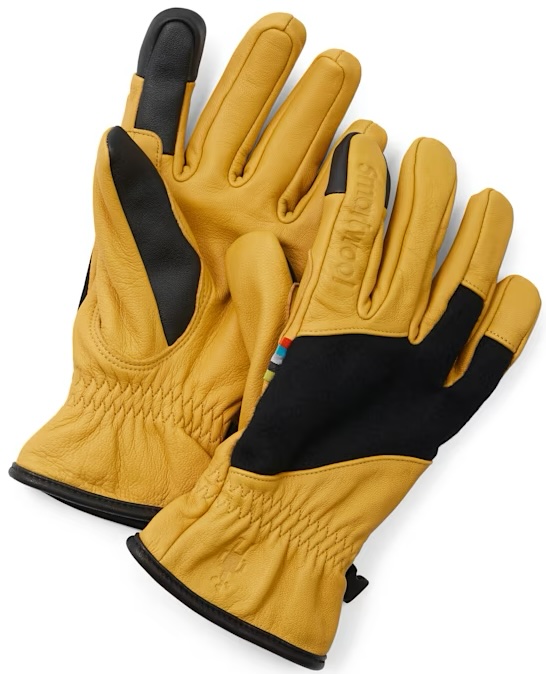 Category: Casual/performance
Category: Casual/performance
Shell: Leather/nylon
Waterproof: No (water-resistant)
What we like: Merino liner offers warmth, temperature regulation, and odor resistance.
What we don’t: Leather exterior isn’t particularly durable.
Merino wool is one of our favorite next-to-skin fabrics, thanks to its great combination of warmth, temperature regulation, and odor resistance. You won’t find a better material for hiking socks, so it goes without saying that it’s well suited for gloves as well. The Smartwool Ridgeway Glove is a well-executed merino design, with a predominantly leather shell and stretchy nylon back, along with a cozy blended merino (70% merino, 30% nylon) lining. For an everyday glove with premium materials, durable construction, and a classy appearance, give the Ridgeway a closer look.
One of merino’s primary weaknesses is durability, so we wouldn’t recommend a glove that places merino on the exterior (such as a merino liner glove). What’s more, we appreciate that Smartwool employed a merino/nylon blend in the Ridgeway, which boosts durability without compromising on any of the merino's sought-after qualities. But if you’re looking for a tough leather work glove, we would advise you to look elsewhere: The Smartwool’s goat leather isn’t particularly robust, and the nylon backer won’t be as easy to waterproof as an all-leather design. But for a modern twist on the leather glove—complete with touchscreen compatibility—there’s a lot to like about the Ridgeway. Keep in mind the glove has been known to run small, so you might want to size up.
See the Smartwool Ridgeway Glove
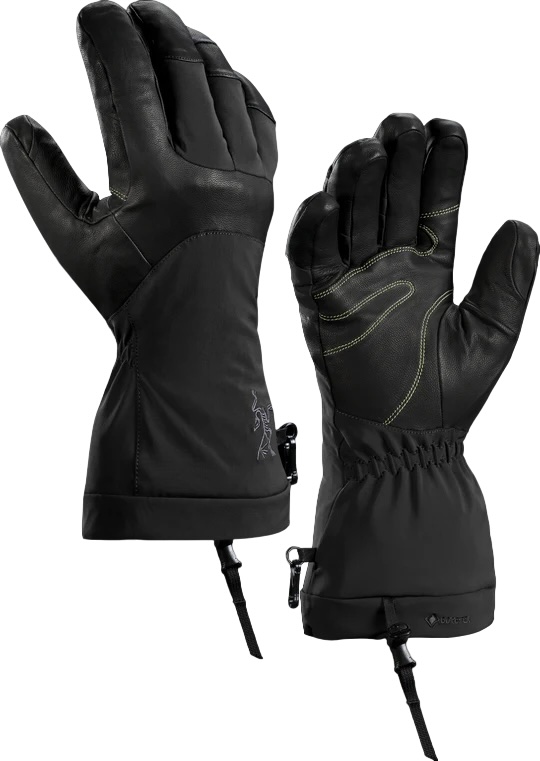 Category: Performance
Category: Performance
Shell: Nylon/leather
Waterproof: Yes (Gore-Tex)
What we like: The best in materials and design.
What we don’t: Potentially overkill and expensive.
The Fission SV is Arc’teryx’s warmest winter glove, made for everything from backcountry skiing and ice climbing to snowshoeing. And as we’ve come to expect from the British Columbia brand, it’s extremely well designed and made with top-quality materials. The softshell and leather exterior is stretchy and tough, and the mix of insulation (133g PrimaLoft Gold at the palm and 300g PrimaLoft Silver at the back of hand) balances warmth with hand feel for gripping a tool or ski pole. A cozy Octa Loft lining offers high-end moisture management (this is one of our favorite next-to-skin materials), and a waterproof Gore-Tex insert, leather palm, and full-coverage gauntlet round out the Fission’s full-on performance build.
Why is this premium offering from Arc’teryx towards the bottom of our list? For most people and uses, we think it’s overkill in both price and features. Most of the time you can get away with a much more affordable glove—in fact, we know several seasoned ice climbers who opt for a design like the Showa 282 TemRes over the Fission SV. Furthermore, you get similar warmth from Black Diamond’s Guide Gloves for $20 less. But if price is not an issue, the Fission SV delivers typical Arc’teryx craftsmanship and high-end performance for the most discerning of outdoor enthusiasts. Note: The Fission has gone out of stock since we last updated this guide, but we reached out to Arc'teryx and they expect it to return.
See the Arc'teryx Fission SV Glove
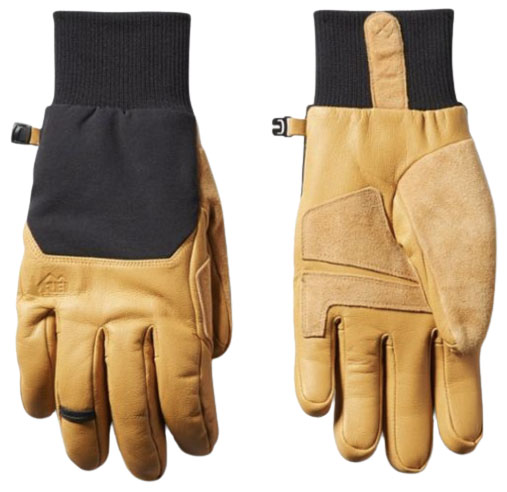 Category: Performance/work
Category: Performance/work
Shell: Leather/softshell
Waterproof: No (water-resistant)
What we like: Work glove looks with useful performance touches.
What we don’t: Not waterproof or very warm.
REI’s in-house line is a great one-stop shop for value, and we like what they’ve come up with in the Guide Insulated. Available in both a glove and a mitten, you get a mostly leather design that mixes traditional work glove looks with techy details like a softshell material on the back of the hand. The unisex model is offered in a range of sizes (from XS to XXL), provides moderate insulation with a combination of synthetic fill and a fleece lining, and includes nice touches like a suede nose wipe on the thumb. For a very reasonable $55, the Guide Insulated packs a serious punch.
How does the REI Co-op Guide Insulated stack up to the Flylow Ridge above? Both have durable leather palms and good dexterity for anything from chopping wood to backcountry skiing, although the Flylow is a bit tougher and more protective with its full leather build. On the other hand, the softshell material on the REI helps keep you comfortable when working up a sweat. We give the edge to the more proven Flylow for now, but the Co-op’s Guide Insulated is nevertheless a worthy addition to any glove quiver.
See the REI Co-op Guide Insulated Glove
| Glove | Price | Category | Shell | Insulation | Waterproof |
|---|---|---|---|---|---|
| Outdoor Research Stormtracker | $79 | Performance/casual | Nylon/leather | Tricot lining | No |
| Carhartt W.P. Glove | $30 | Performance/work | Polyester | Synthetic | Yes |
| Hestra Army Leather GTX Glove | $230 | Performance | Polyamide/leather | Synthetic | Yes (GTX) |
| Outdoor Research Flurry Sensor | $45 | Casual | Wool blend | Wool blend | No |
| Arc’teryx Venta Glove | $75 | Performance | Softshell | Synthetic | No |
| Kinco Heavy-Duty Pigskin Driver | $43 | Work | Leather | Synthetic | No |
| Chaval SuperNova Heated Glove | $425 | Performance | Leather | Synthetic | Yes (Porelle) |
| Hestra Fall Line Glove | $165 | Performance/casual | Leather | Synthetic | No |
| Black Diamond Guide Gloves | $180 | Performance/work | Leather/nylon | Synthetic/wool | Yes (GTX) |
| Showa Atlas 282 TemRes Glove | $22 | Performance/work | Polyurethane | Synthetic | Yes |
| Flylow Gear Ridge Glove | $55 | Work/performance | Leather | Synthetic | No |
| The North Face Denali Etip | $55 | Casual | Fleece | Fleece | No |
| Dakine Titan GTX Glove | $85 | Performance | Polyester | Synthetic | Yes (GTX) |
| Oyuki Sencho GTX | $160 | Performance | Leather | Synthetic | Yes (GTX) |
| Smartwool Ridgeway Glove | $90 | Casual/performance | Leather/nylon | Merino blend | No |
| Arc’teryx Fission SV Glove | $200 | Performance | Nylon/leather | Synthetic | Yes (GTX) |
| REI Co-op Guide Insulated | $55 | Performance/work | Leather/nylon | Synthetic | No |
Many members of the Switchback Travel staff eagerly await dropping temperatures, with visions of chairlifts and snowshoes dancing in our heads. Given our team's love of all things winter, we certainly know how to stay cozy in the cold, whether we're pulling on our bibs in the resort parking lot, bundling up in winter jackets for walks around town, or shoveling the driveway after a big snowfall. Former senior editor and year-round backcountry enthusiast Jenny Abegg kicked off this glove guide in 2019 with 19 of her favorites. Based in Washington state, Jenny is a seasoned mountaineer who doesn't let frigid weather keep her from summiting peaks in the North Cascades. Editor Maddie Downie took over the guide in 2024. Between mountaineering, ski touring, and stubbornly rock climbing in the winter months, Maddie knows how essential a good pair of gloves is for keeping her hands cozy and safe in challenging alpine conditions.
Our current list of 17 gloves has been curated after hours of hands-on testing, research, and gathering feedback from the outdoor community (we took a similar approach with our round-up of the best winter mittens). These gloves have joined us on countless cold, wet, and windy winter escapades, and we’re quick to notice which ones keep us comfortable. When testing gloves, we note the quality of the materials and durability of each pair, as well as their comfort and dexterity. We’re also sure to gauge the features that make them unique, such as touchscreen capabilities, cuff designs, and removable liners. The winter glove market is certainly saturated, but we will continue to test new designs and update this list with our favorites.
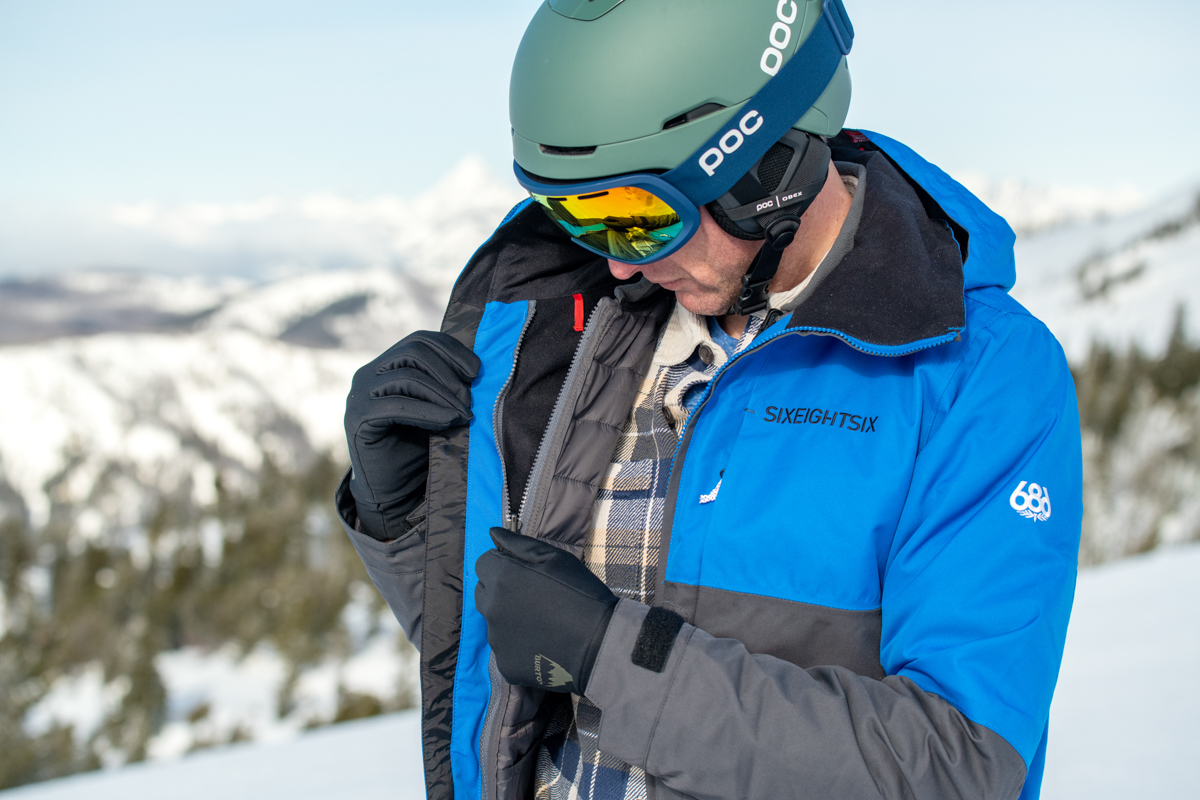
Performance
Performance gloves are designed for sustained use in demanding winter conditions. For mountaineering, skiing, or winter bike commuting, these are the top performers. Obviously, a glove made for high-output activities such as cross-country skiing will have vastly different traits than an arctic expedition glove, so this is a wide category. But consistent features include wind and waterproof materials, quality insulation, good dexterity, grippy palms, snug-fitting cuffs, and often expensive price tags. Leading options include the Outdoor Research Stormtracker, Hestra Army Leather Gore-Tex, and Black Diamond Guide Gloves.
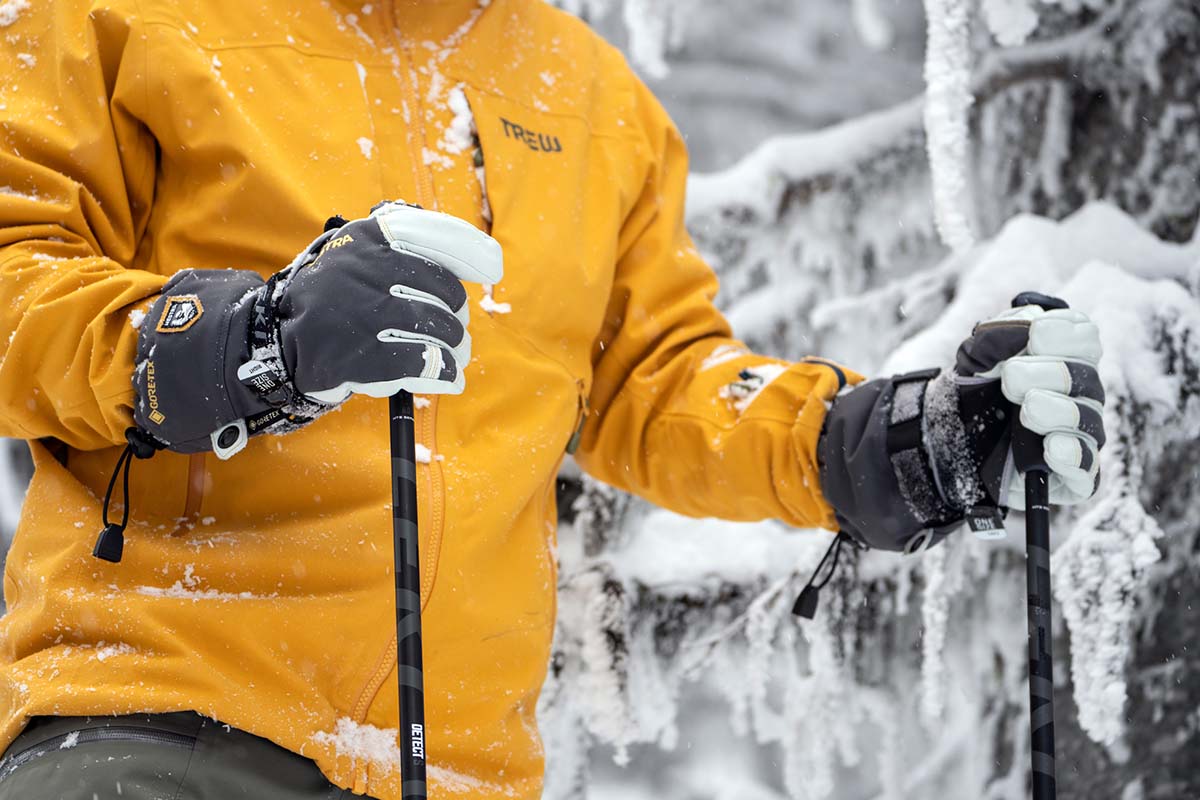
Casual
Casual gloves are our top picks for day-to-day activities such as walking around town, driving to work, or short winter hikes. Some of these gloves are designed with full functionality in mind, while others prioritize styling and warmth. All casual gloves are made to keep your hands protected for brief periods of time in the cold, but many won’t stand up well to precipitation. In this category, look for features like touchscreen-compatible fingertips (seen in our top-ranked Outdoor Research Flurry Sensor), reinforced palms, and materials like fleece and wool. And because they’re not intended for high-end performance, casual gloves are typically among the most affordable.
.jpg)
Work
Gloves in our work category put a premium on durability. For uses like chopping wood or operating a ski lift, a tough leather glove is hard to beat (it’s no coincidence all our work gloves above are made primarily with leather). Also, look for simple feature sets, dexterous styles, reinforced palms, and short, undercuff designs. Most winter-ready work gloves are fleece-lined or synthetically insulated for added warmth, but you can always double up with a liner (at the cost of some dexterity).
In general, work gloves are not made for extreme conditions like true winter sports options, although there are some notable exceptions. The Flylow Ridge and REI Co-op Guide Insulated gloves, for example, cross over into the performance category with designs that balance weather protection, durability, and warmth. We know many winter enthusiasts who routinely wear models such as these for skiing, snowboarding, or ice climbing rather than gloves specifically made for those activities. But take note: Although work gloves often come with a lower price tag, they do not offer the full weather protection of a nylon glove with a long, sealable gauntlet.
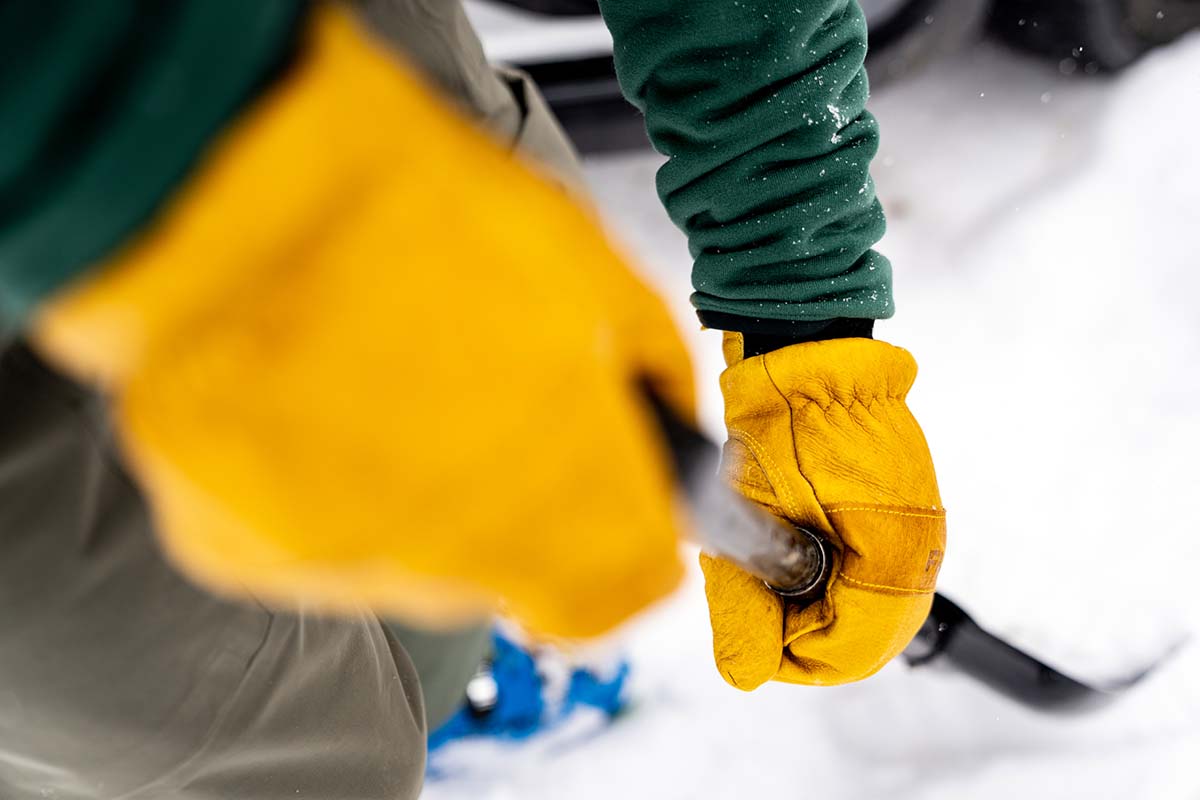
Warmth is a defining feature of a winter-ready glove, and the amount of insulation provided varies widely between styles. On the very warm end of the spectrum are the Arc'teryx Fission SV and Hestra Army Leather, which have thick synthetic fill, windproof shells, and waterproof inserts for keeping you protected in extreme conditions. On the other end is a lightweight fleece glove like The North Face Denali Etip that is only useful for short stints outside in freezing temperatures. And many designs fall in between, like Flylow Gear's Ridge Glove. The premium leather build is dexterous for day-to-day activities, while the moderate level of foam insulation has kept us comfortable on mild-weather ski days and while shoveling snow. The good news is that there is a suitable glove for just about every possible use. Your ideal level of warmth will depend on the expected low temperatures, what activities you’ll be doing, and if you are prone to running hot or cold.
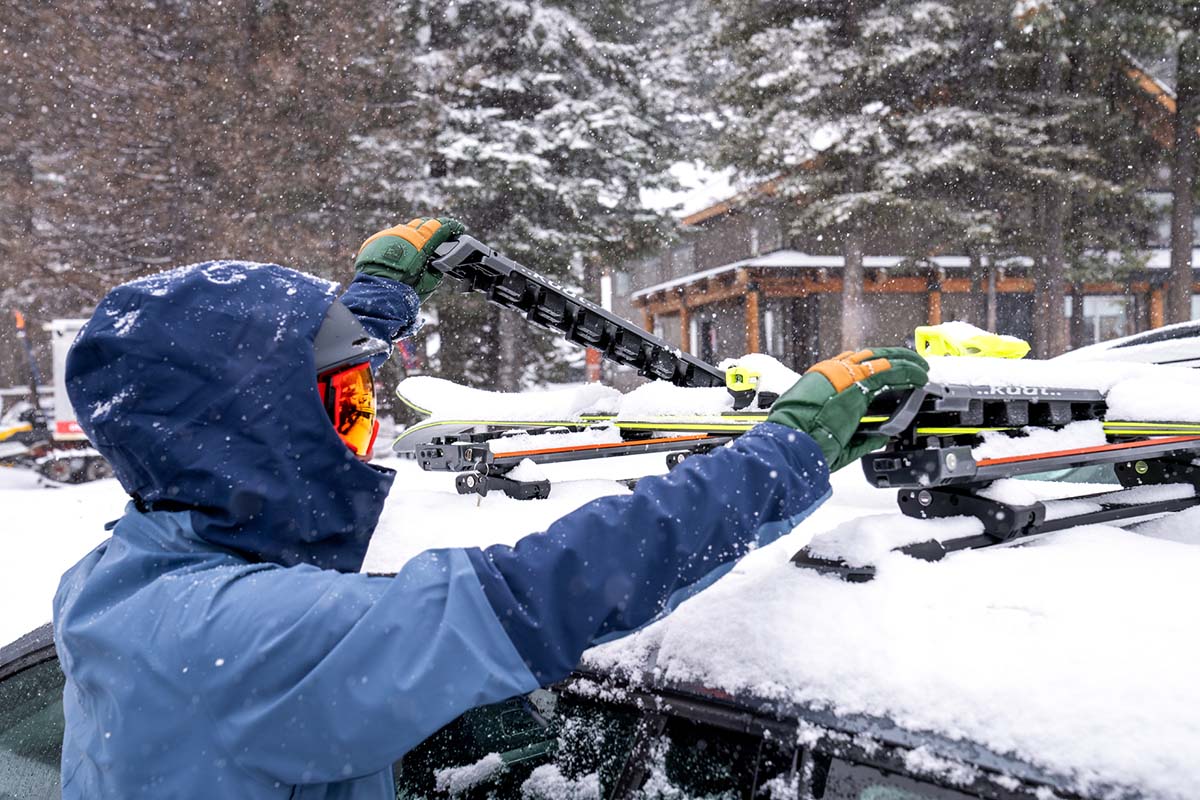
Synthetic
For a seriously warm glove, synthetic fill is our preferred form of insulation. It has all the right properties: Synthetic insulates when wet, is an efficient insulator relative to its weight, is reasonably durable and resists packing out, and is cheaper than down. Many of the top performance gloves on our list use this type of fill, including the Oyuki Sencho Gore-Tex. It’s worth noting that the quality of the synthetic fibers is important—gloves that use PrimaLoft and Thinsulate are warmer for their weight and longer lasting than cheaper options that uses generic polyester fill.
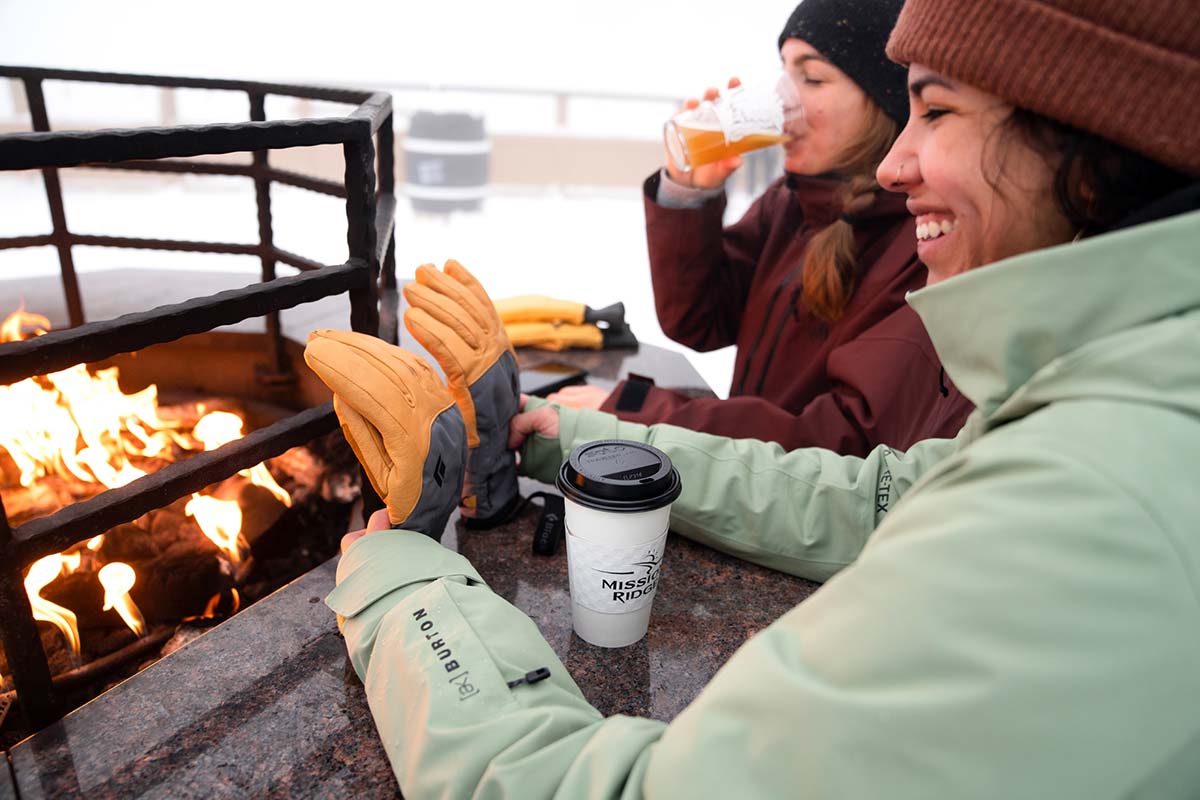
Fleece
Synthetic gloves may dominate the performance category, but fleece is a popular insulator among casual and lightweight designs. A fleece glove like The North Face Denali Etip is cozy, warm enough for short walks outside, and relatively affordable at $55. Downsides of fleece gloves are that they don’t provide much wind and weather protection (on the other hand, they often breathe well), and aren’t as warm as a synthetic glove. But for a cheap and comfortable option to wear around town, fleece is a good way to go.
Wool
Wool, and the merino variety in particular, is our favorite material for next-to-skin baselayers and socks, but it isn’t as popular among winter gloves. It’s true that some of the gloves above use wool—the Outdoor Research Flurry and Smartwool Ridgeway are insulated with wool blends—but it has its fair share of drawbacks. Wool generally has a shorter lifespan than fleece, and is heavier, bulkier, and significantly less durable than synthetic. But there’s no denying its warmth—we like wool for a lightweight liner (worn under a shell) or for casual use in dry conditions.
.jpg)
Many winter gloves are not fully waterproof, but those that are fall into two basic styles: an outer shell that blocks out moisture, or a waterproof membrane sandwiched between the shell and liner. Starting with the waterproof shell design, these gloves are typically made with leather, which resists wind but is naturally prone to absorbing moisture. As such, they require a treatment of Sno-Seal or equivalent product to create a water-blocking barrier. It’s important to note that these gloves also need routine maintenance (washing or reapplication of treatment) to stay in working order (more on this below).
.jpg)
A waterproof shell does the trick in dry snow or if you stay on top of the maintenance, but it can’t compete in terms of all-out water resistance with an internal membrane. The highest quality waterproof layer on the market is Gore-Tex, known for its combination of long-lasting moisture resistance and breathability. Most high-level gloves are made with Gore-Tex, while more budget-oriented gloves feature various off-brand designs, such as BD.dry, DryVent, etc. You can expect varying levels of performance from these fabrics, but in general, a lower price point will mean compromised waterproofing, breathability, or both. Again, cheaper gloves will be fine for most purposes—including mild-weather resort skiing and outdoor work—but if you really want a glove to hold up in wet and miserable conditions, expect to pay a bit more.
For casual use or if you’re not outside for extended periods of time, a non-waterproof glove often will be sufficient. Fleece and wool models offer the least amount of protection, while some, like the leather Hestra Fall Line, are highly wind and water resistant. In general, we recommend a waterproof glove if you’ll be out in the elements for long stretches and will run the risk of wet hands. But more air-permeable designs are a fine choice for wearing around town, while shoveling snow, or even on the occasional snowshoe adventure.
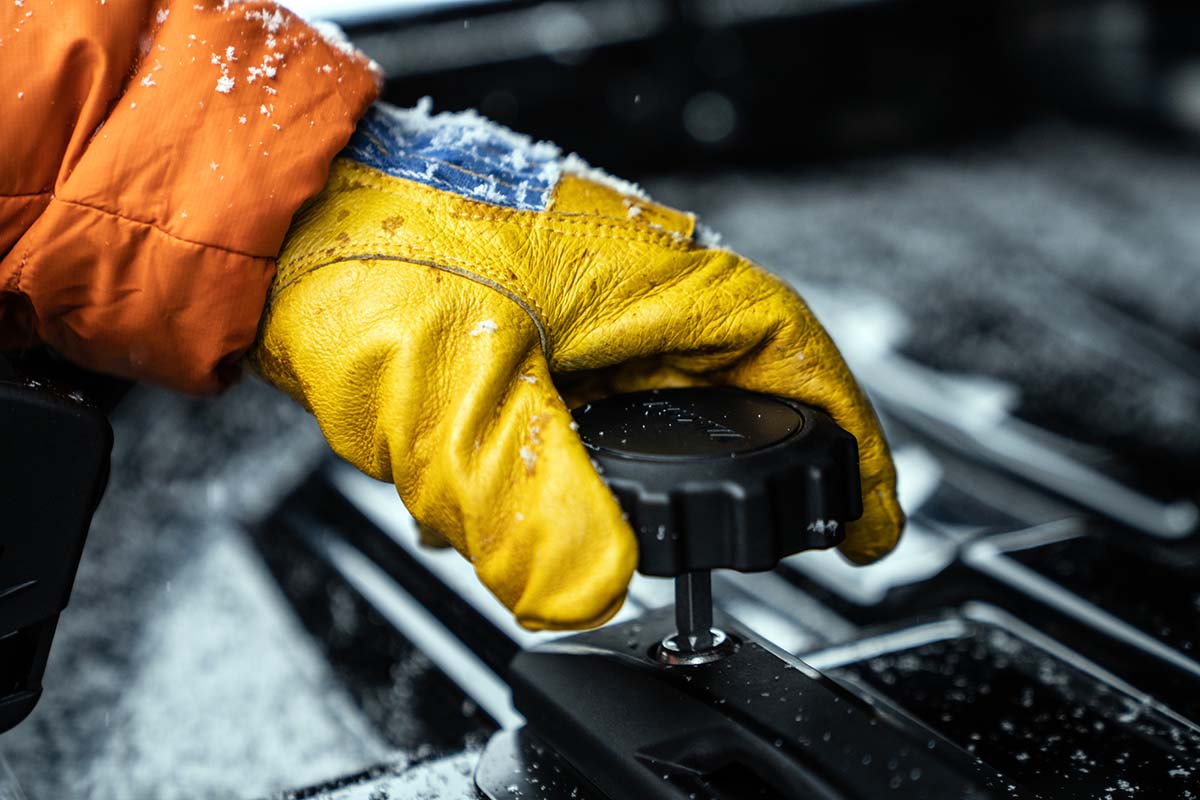
As we touched on in the waterproofing section above, leather gloves require occasional treatment to avoid absorbing moisture. Some models come pre-treated, including Flylow’s Ridge glove, while others like the Kinco Pigskin glove are just plain leather. The most common and effective coating is Sno-Seal. This beeswax-based solution requires a fair amount of effort—including baking the glove in the oven—but it’s a proven formula that’s extremely popular among skiers in wet climates. Simpler and less-involved options that still provide a good level of protection include Nikwax’s Waterproofing Wax and Hestra’s Leather Balm, which can be applied quickly by rubbing in the treatment with a cloth and drying overnight. Depending on how often you wear your gloves and in what kind of conditions, you may need to re-treat the leather one or more times a winter (it’ll be clear when you need to reapply because the gloves will stop shedding moisture).
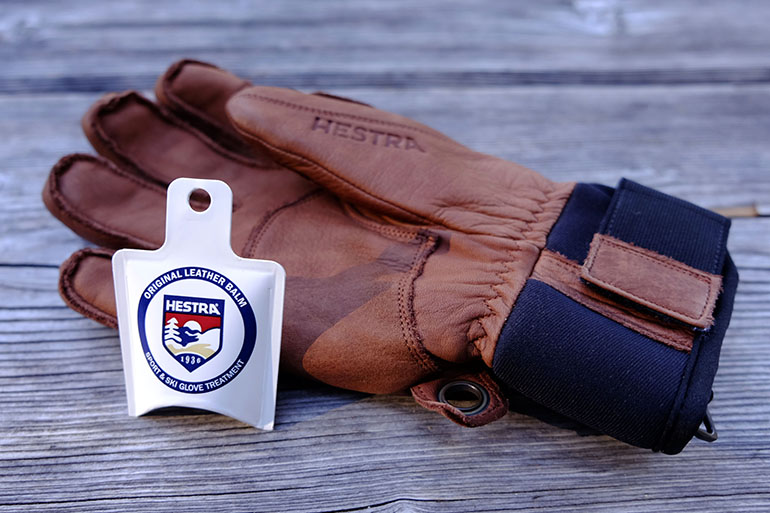
Durability should not be overlooked when it comes to choosing the right glove. After all, what gets more use than our hands? The most long-lasting gloves fall into the work category and are made of ultra-tough leather. An additional waterproofing treatment—such as Nikwax, Sno-Seal, or similar product—provides a barrier from moisture but also serves to extend the glove’s lifespan. Nylon shells are another long-lasting option, particularly well-made performance designs like the Hestra Army Leather Gore-Tex. Simple wool and fleece models are the most prone to developing holes and tears and should be limited to casual activities. It’s worth noting that some nylon, wool, and fleece gloves are reinforced with leather in high-use areas (such as the palms and fingertips).
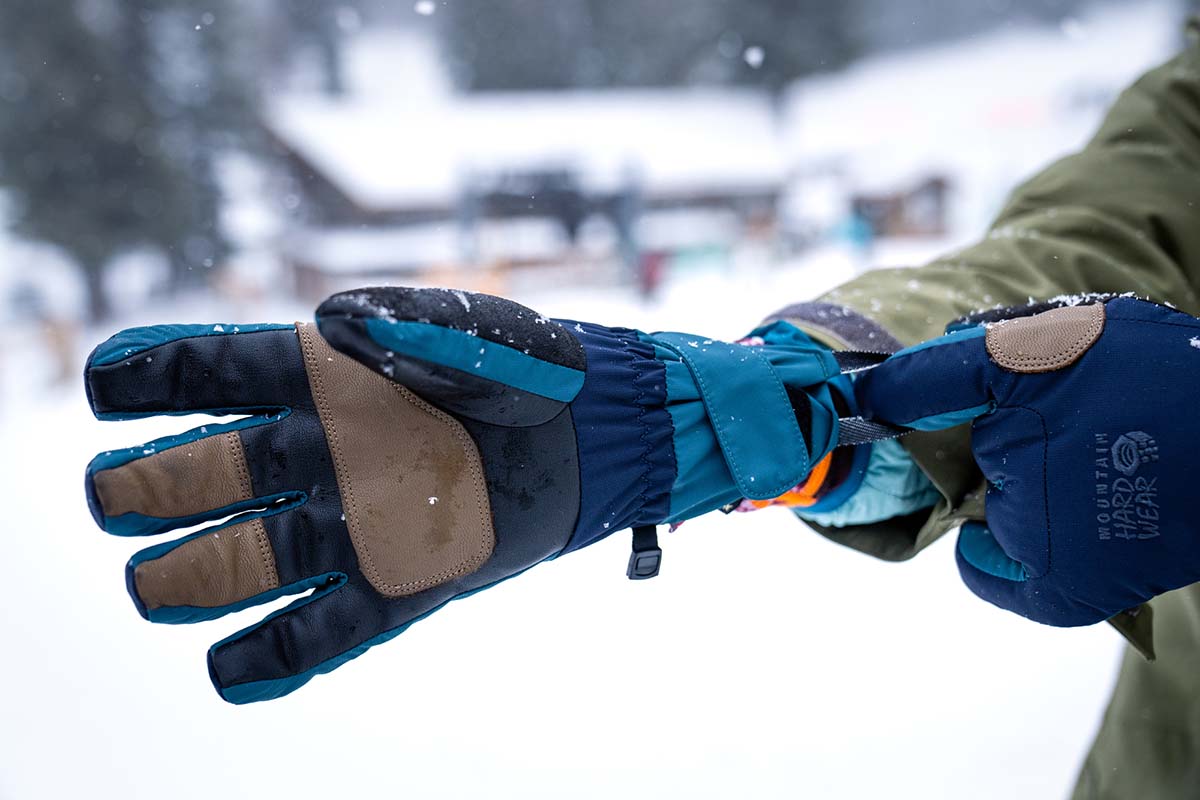
For many wintertime uses, from putting chains on your car in a snowstorm to texting on your smartphone, it’s important to have a pair of highly dexterous gloves. If this is a priority for you, the supple and stretchy nature of leather (even lined leather) makes it a popular choice. Another factor is the level of insulation: In general, thinner and less warm gloves are more dexterous. Finally, the construction plays a role—Hestra’s Fall Line has external seams along the fingers that make it surprisingly easy to perform fine motor movements despite the glove’s warm foam insulation. Keep in mind that dexterity doesn’t need to be the top consideration for everyone—thick or bulky gloves can still be useful in many situations, including shoveling snow, skiing, or just walking in extreme cold.
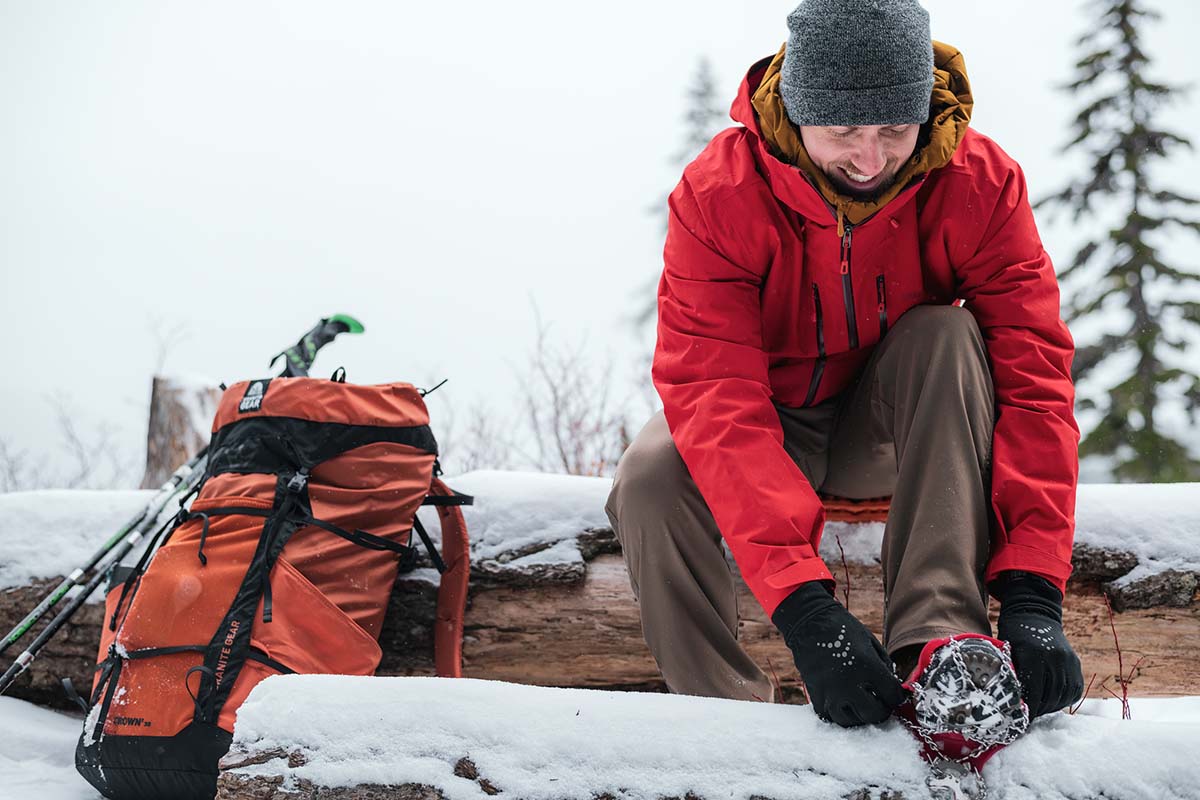
Gauntlet Style
Gauntlet gloves, like the Black Diamond Guide, extend over the cuff of a jacket (rather than under), providing excellent weather protection and warmth. When done right, a gauntlet effectively seals out cold air and virtually eliminates the possibility for snow to enter. Gauntlet gloves are easy to get on and off, with large openings and one-handed drawcords that tighten and release. They are often heavier, bulkier, less agile, and less ventilated than other styles, but worth it if you really want to batten down the hatches. We like the gauntlet style best as high-performance gloves for winter sports and expeditions.
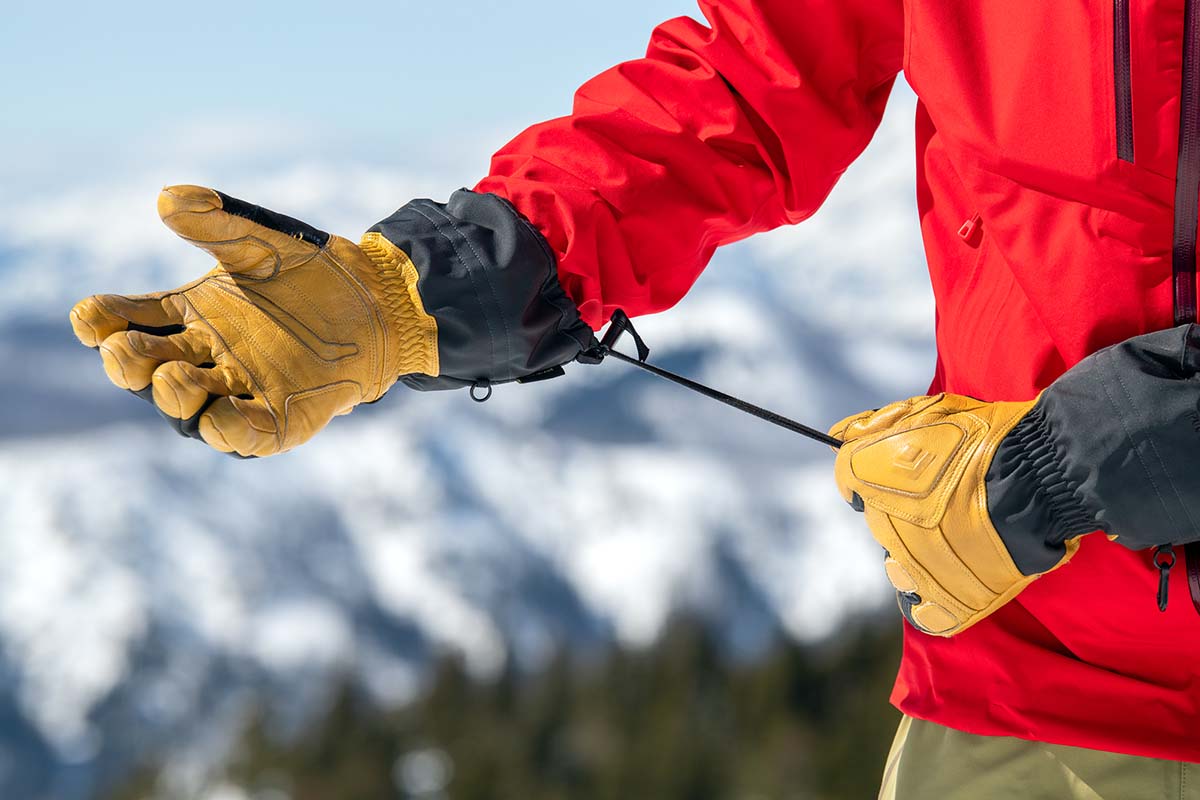
Undercuff
Undercuff gloves—usually incorporating a cuff made with stretchy wool or synthetic material—sit under the winter jacket and hold the glove close to the wrist. The cuff provides both a barrier from the elements and keeps the glove from slipping off the hand. While an undercuff glove is less bulky, lighter weight, and better at ventilating than a gauntlet style, it can’t compete in terms of weather protection. Even if you tighten your jacket sleeves snugly over the top, there’s a chance your sleeves will ride up during activity. But for outdoor work or everyday use, the simplicity of an undercuff design is very appealing.
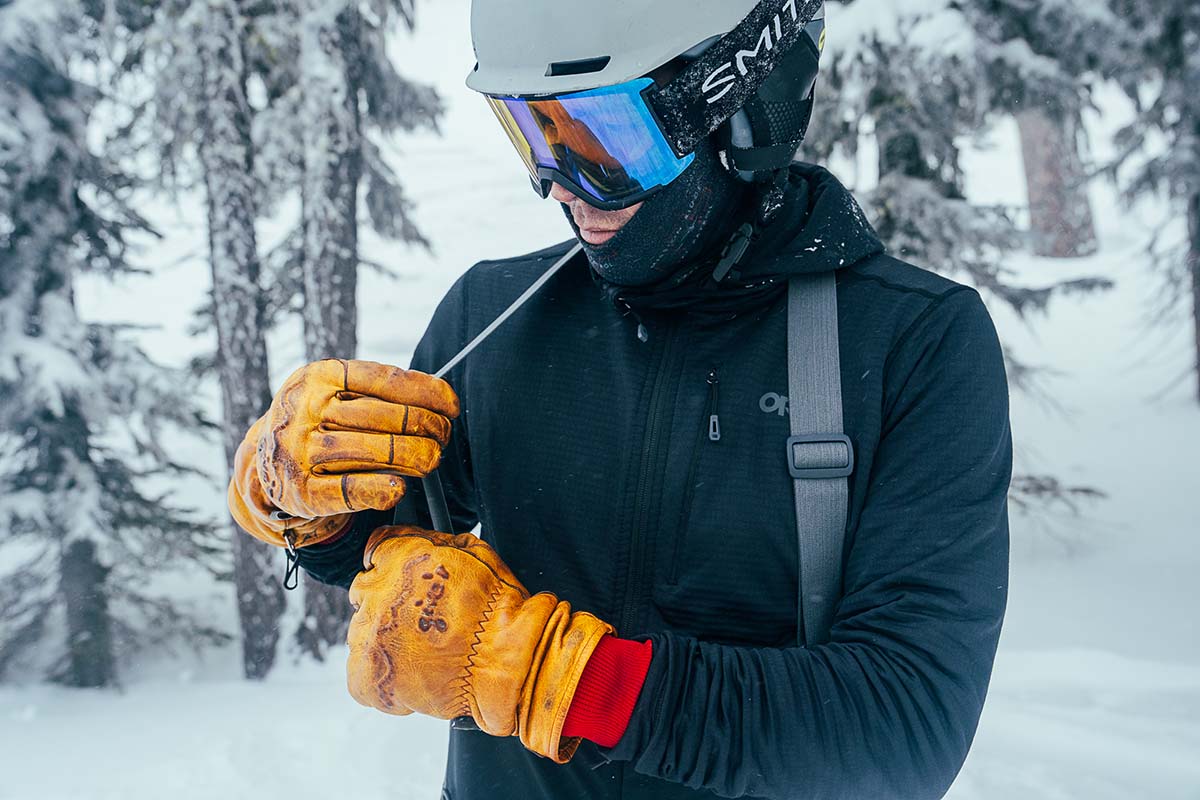
Many gloves come with either a built-in or removable liner (the latter often are referred to as 3-in-1 gloves). Made from synthetic or wool, a liner wicks moisture away from the skin and adds an element of warmth, even when wet. A liner that can separate from the glove provides added versatility—you can wear the liner or shell separately (keep in mind not all liner gloves are made for standalone use), or combine them for maximum warmth. Furthermore, separating the layers allows for faster drying and the ability to swap liners in the middle of a particularly wet day. 3-in-1 gloves are bulkier, heavier, and less dexterous, but certainly have their merits. And keep in mind that even if a glove is not sold with a liner, you can always layer it with a thinner set for added warmth.
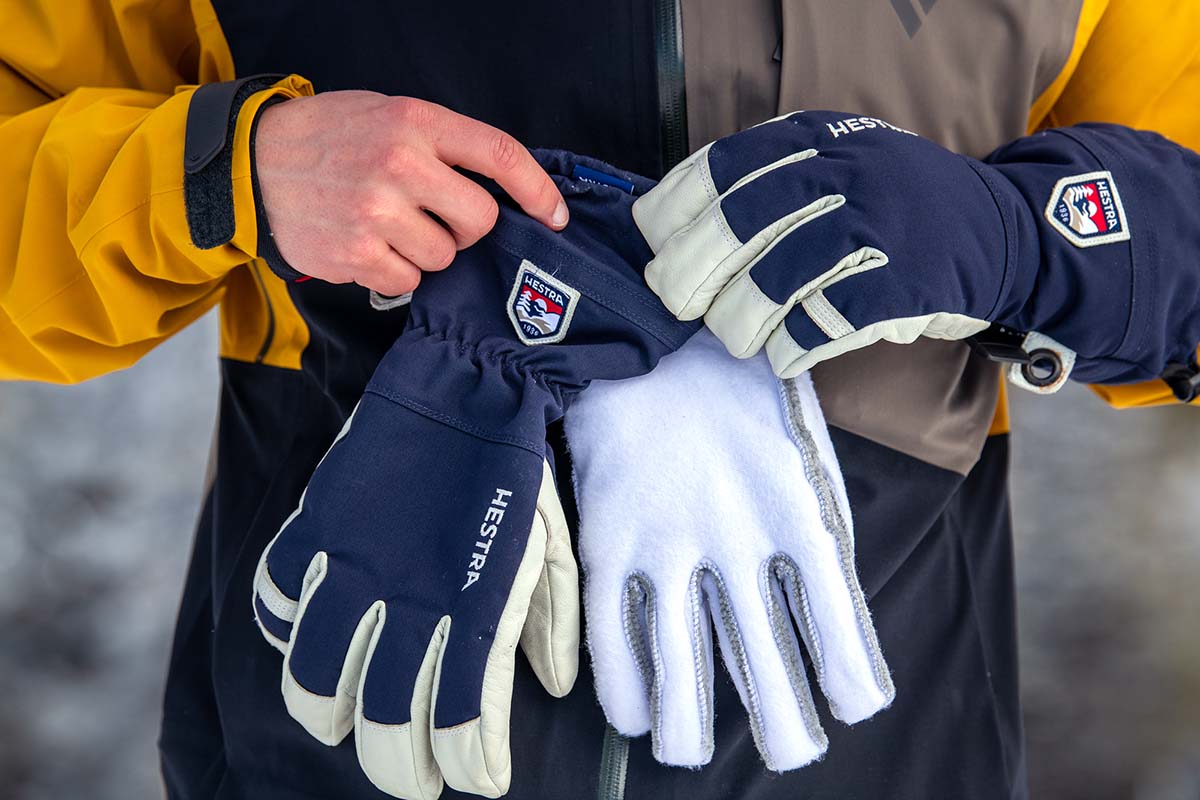
We’re on our phones more now than ever, and in 2025 we see this reflected in glove design. Over half of the gloves on this list feature touchscreen-compatible pointer fingers and thumbs, and the number of available designs are increasing each year. In short, the technology uses conductive fabrics in the fingertips so that your body’s electric current—what the screen must recognize to be responsive—is transferred through the glove (interestingly, you can make this modification yourself with a simple needle and conductive thread). As expected, thin gloves work better on a touchscreen than thick gloves (a simple matter of accuracy). This makes a glove with a touchscreen-compatible removable liner appealing: You get the warmth of a heavy winter glove but the ability to use your phone without fully exposing your hand to the elements.
.jpg)
Winter gloves can range from simple leather designs like the Kinco Pigskin to fully featured models with wrist cinches, nose wipes, zippered pockets, and carabiner loops for carrying on a harness. These features generally increase with performance—everyday and work gloves are usually the simplest (sometimes with touchscreen compatibility as the only noteworthy addition), whereas winter sports gloves often include all the bells and whistles. Some gloves even come with a battery-powered heat pack for particularly cold environments—or particularly cold hands (the Chaval SuperNova Heated Glove being our favorite).
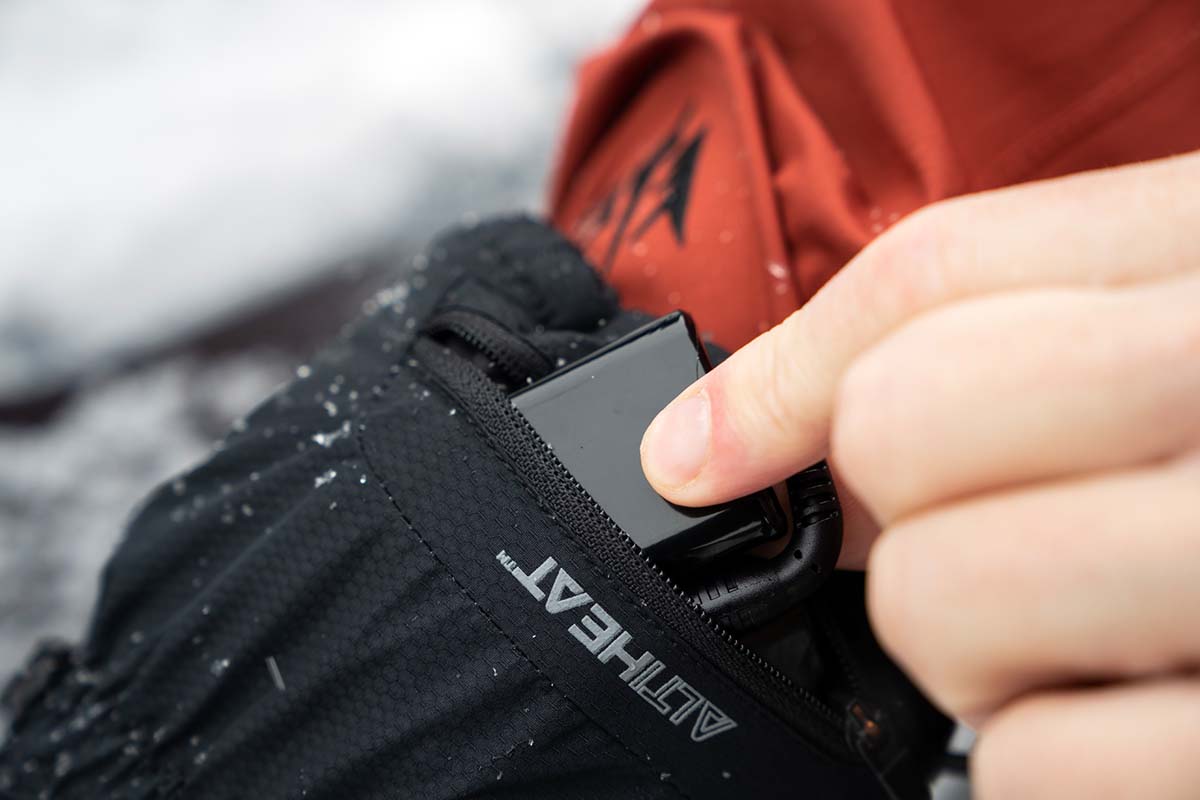
For the chilliest of conditions or those that suffer from habitually cold hands, mittens are a great choice. By keeping your fingers together rather than isolating them as gloves do, mittens offer a notable increase in protection and warmth. The largest downside of mittens is the lack of dexterity. Even for simple tasks like tying your shoes, unzipping your pockets, or grabbing a small item, mittens are bound to make you feel clumsy. Depending on the activity, you may end up removing them enough times that your hands would have stayed warmer with gloves on. But for the occasions when you don’t need nimble hands, nothing beats the warmth of mittens (for more info, see our article on the best winter mittens).
Some gloves—like the Smartwool Active Fleece Wind Mittens—are designed with mitten flaps that extend over the top of gloved fingers. For casual use, this can be a best-of-both-worlds scenario—convenience, dexterity, and warmth all in one. But take note that the partial flap will not suffice to keep your hands dry in snow or rain. A third option for mittens is the 3-finger design, which is also known as the split finger or lobster glove. Here, the thumb and pointer finger have their own slots while the other three fingers remain together as in a mitten. We don’t love this style in most cases—dexterity still is largely compromised and the increase in warmth is minimal.
Back to Our Top Winter Glove Picks Back to Our Winter Glove Comparison Table